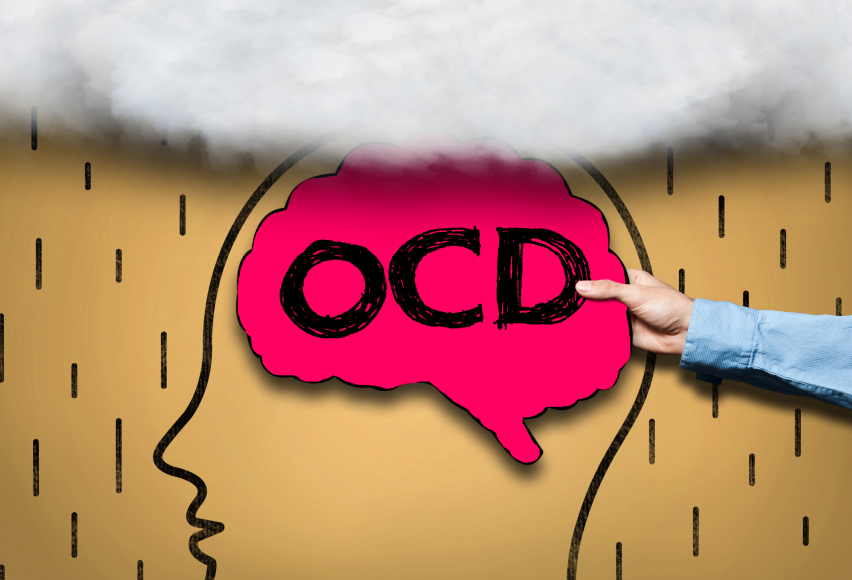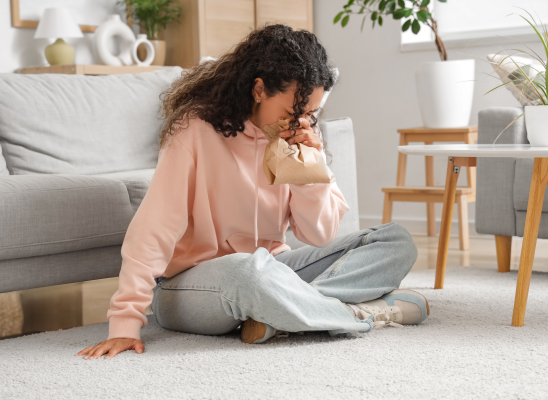
Online test
Find out the severity of your symptoms with this free online test
Obsessive-Compulsive Disorder (OCD) is a chronic and often debilitating mental health condition characterized by persistent, unwanted thoughts (obsessions) and repetitive behaviors (compulsions). These behaviors are performed in response to the obsessions, often to prevent or reduce distress or avoid a feared event or situation.
One of the most challenging aspects of OCD is its cyclic nature, where intrusive thoughts and compulsive behaviors feed into one another, creating a self-perpetuating loop that is difficult to break. This cycle can significantly affect a person’s psychosocial functioning and leave them feeling frustrated, embarrassed, or even ashamed.
Just what does the cycle of OCD look like and what does that mean for someone struggling with OCD? In this article we will take a closer look at the cycle of OCD and best practices for treating OCD.
The OCD Cycle
The OCD cycle is deeply rooted in one of our most basic, primal instincts – the “fight or flight” instinct. There’s an area deep in our brains, known as the amygdala, which is always on guard for signals of danger. When it senses danger, it sends a cascade of neurochemical messages that trigger a response. The problem is the brain can’t always distinguish between real and perceived danger. In other words, to the brain, sometimes everything looks like a T-Rex.
For people living with OCD, they are often in a heightened state of “fight or flight”. Research has found significant involvement of the amygdala and other areas of the brain that supports the persistent distress associated with OCD.
The OCD cycle is essentially an experiential loop. Each piece of the loop links to the next. Left uninterrupted, it continues to occur and reinforce the cycle.
The OCD cycle consists of four main components:
- Obsessions/intrusive thought
- The interpretation of the thought
- Distress/Anxiety
- Compulsions
- Temporary Relief
The relief is temporary and does not eliminate the obsessions. When the obsession returns, the person again engages in the ritual, creating a vicious cycle of distress and reinforcing the disorder.
The cycle starts with an obsession. Here’s how it works.
Obsessions
Obsessions are intrusive, unwanted thoughts, images, or urges that repeatedly enter a person’s mind. These thoughts are what’s known as ego-dystonic, meaning that they go against the person’s beliefs or values. In short, people who suffer from OCD don’t want to think those thoughts. A new mom might notice having aggressive thoughts towards her baby, a man who values cleanliness might have intrusive pictures coming up in his mind of bacteria on a door knob. The thoughts are unwanted, distressing and anxiety-provoking. Sometimes they feel like an inner bully who knows exactly where it hurts.
Interpretation
The thing is, we all get these thoughts from time to time. Intrusive thoughts are very common and can be related to any topic imaginable. However, people without OCD are able to recognize these thoughts as untrue and not meaningful to them. For people with OCD, those thoughts are interpreted as “danger”, and their brain sounds the alarm.
Anxiety/Distress
The obsessions trigger intense anxiety or distress. This anxiety is a natural emotional response to taking the intrusive thought seriously, as the person feels overwhelmed by the fear that the obsession might come true or that the thought is related to their own personality and intentions. As the anxiety builds, the person seeks relief. The anxiety serves as a powerful motivator for the next step in the cycle.
Compulsions
Compulsions are the repetitive actions someone takes to alleviate their anxiety and distress created by the obsessions. Compulsions can be physical actions, such as washing hands excessively, checking locks repeatedly, arranging items in a particular order, seeking reassurance from others or avoiding certain objects and situations. They can also be mental acts, sometimes referred to as mental rituals, like counting silently, praying, or repeating certain words or phrases.
Compulsions are performed with the belief that they will prevent a feared outcome or reduce the anxiety associated with the obsession. However, while compulsions may provide temporary relief, they do not address the root cause of the obsession, and the relief is short-lived.
Temporary Relief and Reinforcement
After performing a compulsive act, there is typically a temporary relief from anxiety and distress. However, it’s essentially the calm before the storm. The relief is short-lived, and the obsessive thoughts come flowing back in, often more intensely than before. The person again seeks to relieve the distress and engages in compulsive behavior and finds some relief.
Ironically, it is the thing the person seeks most, relief, that reinforces the compulsive behaviors. The temporary relief reinforces the compulsion, making it more likely that the person will engage in the behavior again the next time the obsession arises.
This reinforcement strengthens the OCD cycle, making it more entrenched and harder to break. Over time, the compulsions can become more elaborate or time-consuming as the person perceives the obsession as a real threat and tries to achieve the same level of relief.
What Does the OCD Cycle Look Like?
While the components of the OCD cycle remain the same, how the cycle presents can differ depending on someone’s unique experience. Here are a few examples of what that cycle might look like in some of the common types of OCD:
Contamination OCD
Contamination OCD focuses on the fear of germs or of contracting and spreading illness. The fear may be disgust-based (e.g., feeling unclean or dirty) or harm-based (e.g., fear of being contaminated by germs).
- Obsession: A person has intrusive thoughts about contracting a deadly illness from touching doorknobs.
- Interpretation: They take this thought seriously and believe that there is a chance that this might actually happen.
- Anxiety: This interpretation causes intense anxiety and a need to avoid sources of contamination.
- Compulsion: To alleviate this anxiety, the person might wash their hands repeatedly, sometimes for hours, until they feel "clean" enough, they may wear protective clothing, gloves, etc.
- Temporary Relief: The hand washing brings temporary relief, but the obsession returns, and the cycle begins again.
Religious OCD
Religious OCD, a common type of OCD, focuses on the fear of violating some religious or moral doctrine, committing blasphemy, or offending/angering God.
- Obsession: The person fears being punished by God or not pleasing God in some way.
- Interpretation: The person interprets their fear as likely based on their beliefs and exaggerates the likelihood that it could happen (or has happened).
- Anxiety: This interpretation causes intense anxiety and a need to repent or make amends for their perceived sins.
- Compulsion: To reduce the anxiety, the person engages in excessive amounts of prayer, attending church, or even self-inflicted punishment as an act of contrition.
- Temporary Relief: The prayer or penance provides temporary relief from the fear that they’ve sinned or offended God, but the obsession returns and the cycle continues.
Checking OCD
Checking OCD is a very common type of OCD in which the person engages in checking compulsions to reduce the fear of or chance of something bad happening to them or those around them.
- Obsession: This common obsession involves the fear that something catastrophic will happen if certain actions are not completed correctly, such as locking the door or turning off the stove before leaving home.
- Interpretation: The person falsely interprets the possibility as probability and exaggerates the likelihood of them forgetting to lock the door and the catastrophic outcome they imagine.
- Anxiety: The thought of leaving the door unlocked or the stove on creates significant distress and fear that they might be responsible for resulting harm or damage.
- Compulsion: To reduce this anxiety, they might check the door or stove multiple times, or have a ritual that they use, even when they know they’ve locked the door or turned the stove off. It can sometimes take hours to complete their ritual to their satisfaction and comfort.
- Temporary Relief: The act of checking brings temporary relief, but the obsession returns, and they are compelled to continue checking, sometimes over and over. and checking again.
Breaking the OCD Cycle: Treatment Options
Treating OCD involves a process of breaking the cycle by addressing obsessions, reducing the associated anxiety, and eliminating compulsive behaviors. The most effective treatment for OCD is a specialized form of Cognitive Behavioral Therapy (CBT) known as Exposure and Response Prevention (ERP), and medication.
Exposure and Response Prevention (ERP)
Exposure and Response Prevention is considered the “gold standard” for treating OCD. It is proven to be highly effective and well-received by those seeking help. ERP involves a process of exposing individuals to their obsessive thoughts or fears, learning to lean into the feelings they provoke, and learning to resist the urge to engage in the ritual behaviors Over time, this helps to reduce the anxiety compulsive behavior without allowing them to engage in the corresponding rituals. Over time, this helps reduce the anxiety associated with the obsession, and helps them learn that the feared outcome does not occur even when they do not perform the compulsion, breaking the cycle of compulsive behavior.
For example, a person with contamination OCD might be gradually exposed to touching doorknobs without washing their hands afterward. Initially, this exposure may increase anxiety, but with repeated practice, the anxiety diminishes, and the compulsion to wash hands becomes less intense.
Medication
While generally not a stand-alone treatment for OCD, medication can play an important role in treatment. One group of medication, Selective Serotonin Reuptake Inhibitors (SSRIs), are often prescribed to help manage OCD symptoms.
SSRIs work by increasing the levels of serotonin, a neurotransmitter in the brain that is believed to be involved in mood regulation. By increasing serotonin levels, SSRIs can help reduce the intensity of OCD symptoms, making it easier for individuals to engage in therapy and resist compulsive behaviors.
Cognitive Behavioral Therapy (CBT)
CBT is a type of psychotherapy that focuses on changing negative thought patterns and behaviors. For OCD, CBT helps individuals recognize and challenge their obsessive thoughts and reduce their reliance on compulsive behaviors. An important part of CBT is cognitive restructuring, which involves identifying and challenging distorted thinking patterns that contribute to OCD. By replacing these irrational beliefs with more realistic ones, the person can reduce the intensity of their obsessions and compulsions.
Combination of Medication and Therapy
Research has shown that a combination of CBT (particularly ERP) and medication is often more effective than either treatment alone. Medication can help reduce the severity of symptoms, while therapy provides the tools needed to address the underlying thought patterns and behaviors that sustain the OCD cycle.
Lifestyle Changes and Support
In addition to formal treatment, lifestyle changes can also play a role in managing OCD. Regular exercise, a healthy diet, and sufficient sleep (the Big 3) can help improve overall mental health and reduce OCD symptoms. Support groups and therapy can provide valuable social support and coping strategies.
Conclusion
The cycle of OCD can be difficult to break, but with the right treatment, it is possible to manage and reduce OCD symptoms. Treatment options including Exposure and Response Prevention (ERP), and medication when needed, offers help and hope for lasting management of OCD symptoms. Understanding the cyclic nature of OCD is the first step toward breaking the cycle and achieving lasting relief. There is help and there is hope.
References
1. Simon, D., Adler, N., Kaufmann, C., & Kathmann, N. (2014). Amygdala hyperactivation during symptom provocation in obsessive-compulsive disorder and its modulation by distraction. NeuroImage. Clinical, 4, 549–557. https://doi.org/10.1016/j.nicl.2014.03.011
2. American Psychological Association. (n.d.). APA dictionary of psychology. Retrieved from https://dictionary.apa.org/obsession
3. American Psychological Association. (n.d.) APA dictionary of psychology. Retrieved from https://dictionary.apa.org/ego-dystonic
4. American Psychological Association. (n.d.). APA dictionary of psychology. Retrieved from https://dictionary.apa.org/compulsion
5. Song, Y., Li, D., Zhang, S., Jin, Z., Zhen, Y., Su, Y., … Li, X. (2022). The effect of exposure and response prevention therapy on obsessive-compulsive disorder: A systematic review and meta-analysis. Psychiatry Research, 317, 114861. https://www.sciencedirect.com/science/article/abs/pii/S016517812200453X
6. Soomro, G. M., Altman, D., Rajagopal, S., & Oakley-Browne, M. (2008). Selective serotonin re-uptake inhibitors (SSRIs) versus placebo for obsessive compulsive disorder (OCD). The Cochrane database of systematic reviews, 2008(1), CD001765. https://doi.org/10.1002/14651858.CD001765.pub3
7. Del Casale, A., Sorice, S., Padovano, A., Simmaco, M., Ferracuti, S., Lamis, D. A., Rapinesi, C., Sani, G., Girardi, P., Kotzalidis, G. D., & Pompili, M. (2019). Psychopharmacological Treatment of Obsessive-Compulsive Disorder (OCD). Current neuropharmacology, 17(8), 710–736. https://www.ncbi.nlm.nih.gov/pmc/articles/PMC7059159/
Online test
Find out the severity of your symptoms with this free online test
Start your journey with StopOCD
Take control of your life and find freedom from OCD through professional therapy and evidence-based cognitive behavioral techniques.
Start Now



